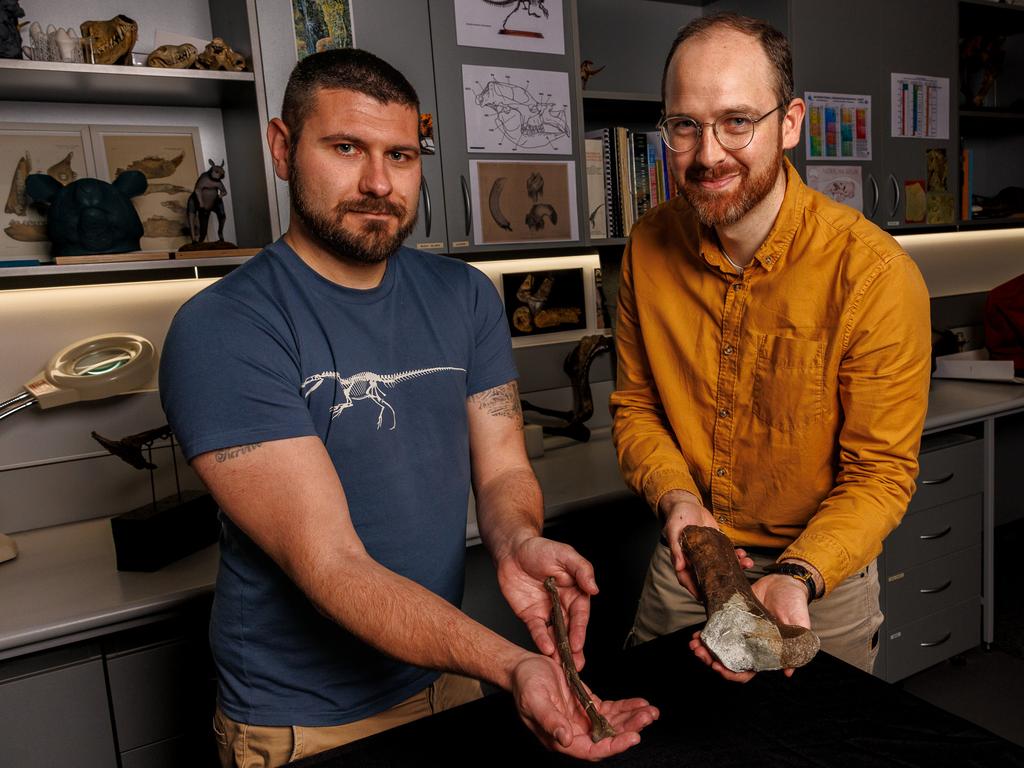‘Groundbreaking’ Aussie dinosaur discovery of new apex predator
Landmark new evidence points to a unique food chain led by a previously undiscovered carnivorous dinosaur that roamed the Australian continent over 100 million years ago

READING LEVEL: ORANGE
The previously unknown existence of a large apex predator* has been discovered, uncovering a carnivore* hierarchy* unique to the prehistoric Australian continent.
The research describes five theropod fossils discovered between 1988 and 2023 in Bunurong/Boonwurrung Country (Bass Coast) and the Eastern Marr Country (Otway Coast).
Theropods* are classified as carnivorous dinosaurs that walked on two legs with hollow, thin-walled bones and they usually had small forelimbs – the Tyrannosaurus is a famous example.
The formal identification of the fossils was led by Monash University PhD candidate* Jake Kotevski and the Museums Victoria Research Institute.
The landmark* study revealed that Victoria’s ancient ecosystem* was dominated by large, powerful megaraptorids* six to seven metres long, alongside smaller carcharodontosaurs* between two to four metres long, and agile, metre-long unenlagiines*, or “southern raptors”.

As the first evidence of carcharodontosaurs in Australia, the discovery marks a significant contribution to the global theropod fossil record.
“The discovery of carcharodontosaurs in Australia is groundbreaking,” Mr Kotevski said.
“It’s fascinating to see how Victoria’s predator hierarchy diverged from South America, where carcharodontosaurs reached Tyrannosaurus rex-like sizes up to 13 metres, towering over megaraptorids. Here, the roles were reversed, highlighting the uniqueness of Australia’s Cretaceous* ecosystem.”
Two of the newly-described fossils represent the oldest known megaraptorids globally.
“Museum collections are crucial to advancing our understanding of prehistoric life”, said Museums Victoria Research Institute vertebrate* palaeontology* collection manager Tim Ziegler. “Specimens preserved in the state collection for decades – unidentifiable until now – are providing new insights into the evolution* of dinosaur ecosystems”.

The findings highlight Victoria’s unique Cretaceous fauna* and offer “compelling evidence of faunal interchange” between Australia and South America through Antarctica during the Early Cretaceous, Museums Victoria Research Institute senior curator* Dr Thomas Rich said.
Key fossil sites are still being surveyed by Mr Kotevski and the team as part of Monash’s Dinosaur Dreaming project.
The survey has uncovered more than 10,000 fossil bones and teeth since the project began in 1994 – including at least seven different dinosaurs, three groups of mammals, birds, pterosaurs*, plesiosaurs*, turtles and fishes.
POLL
GLOSSARY
- apex predator: animal at the top of the food chain, that kills and eats other animals but is not normally eaten themselves
- carnivore: an animal that eats meat
- hierarchy: a system in which people, animals or things are arranged according to their importance
- theropods: a type of dinosaur that walked on its back legs (bipedal) and had short front legs
- PhD candidate: a postgraduate student yet to submit their doctoral thesis
- landmark: refers to an event or discovery of great importance and significance
- ecosystem: refers to all of the living and non-living things in an area
- megaraptorids: large theropods with big claws
- carcharodontosaurs: very large meat-eating dinosaur
- unenlagiines: lightly built and very fast, these predatory dinosaurs were likely feathered
- Cretaceous: the period between around 144 and 65 million years ago, in which plants with flowers first appeared, the last period of the Mesozoic Era, following the Jurassic
- vertebrate: any animal with a spine
- evolution: gradual process of change and development
- fauna: all of the animal life present in a particular region or time
- curator: person in charge of a department of a museum or other place where objects of art, science, or from the past are collected
- pterosaurs: long-lived and diverse group of flying reptiles that first appeared in the fossil record during the early-middle Late Triassic, making them the first flying vertebrates in history
- plesiosaurs: extinct marine reptile of Jurassic and Cretaceous times with a long neck, short tail and paddle-like limbs
EXTRA READING
Dino girl scans outback sauropods
Can you guess this tyrannosaur’s final meal?
Young dinosaur was crocodile’s last meal
QUICK QUIZ
- What are theropods classified as?
- How long were the megaraptorids that dominated Victoria’s ancient ecosystem?
- How did that ecosystem diverge from South America’s?
- What is the name of the Monash University project with the Museums Victoria Research Institute?
- How many fossil bones and teeth have been uncovered since the project began in 1994?
LISTEN TO THIS STORY
CLASSROOM ACTIVITIES
1. How could it happen?
Do you know how there could be “interchange” between Australia and South America during the Early Cretaceous period, which was between 145 and 100 million years ago?
Brainstorm some ideas then use your research skills to find out. Use the information that you have found to create a poster or diagram that will help younger kids understand how this could have happened.
Time: allow at least 45 minutes to complete this activity
Curriculum Links: English, Geography, Science
2. Extension
How do you think the scientists were able to identify that the fossils were carcharodontosaurs? Write the steps that you think they could have used to investigate and identify the fossils. Use information in the story to help you.
Time: allow at least 25 minutes to complete this activity
Curriculum Links: English, Science
VCOP ACTIVITY
To sum it up
After reading the article, use your comprehension skills to summarise in a maximum of three sentences what the article is about.
Think about:
What is the main topic or idea?
What is an important or interesting fact?
Who was involved (people or places)?
Use your VCOP skills to re-read your summary to make sure it is clear, specific and well punctuated.

